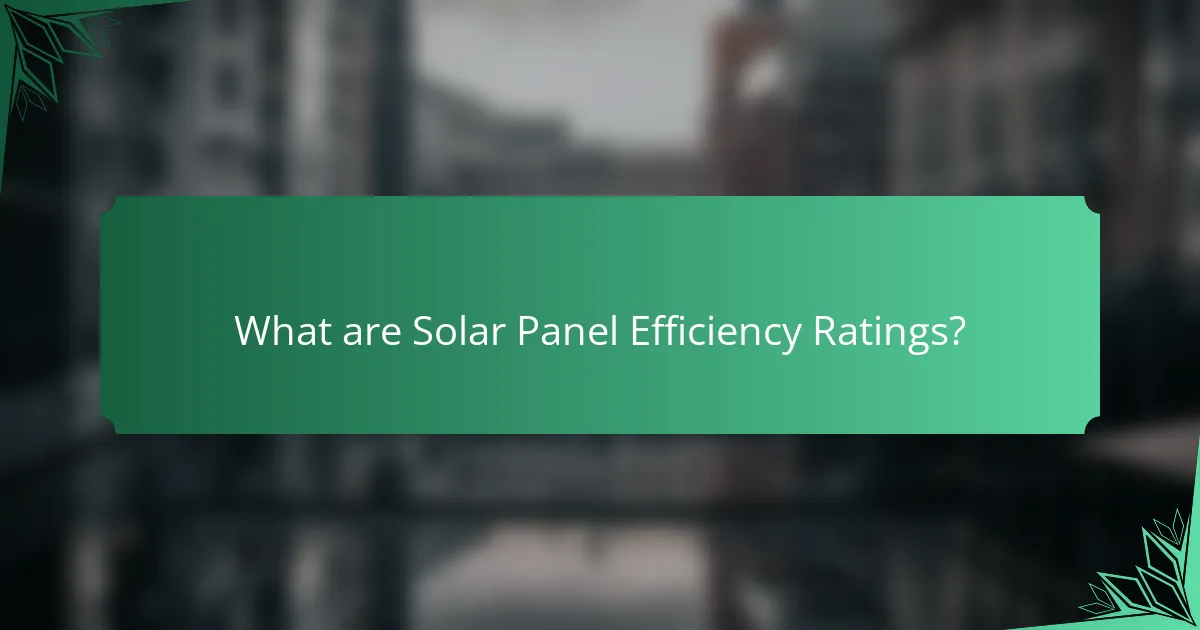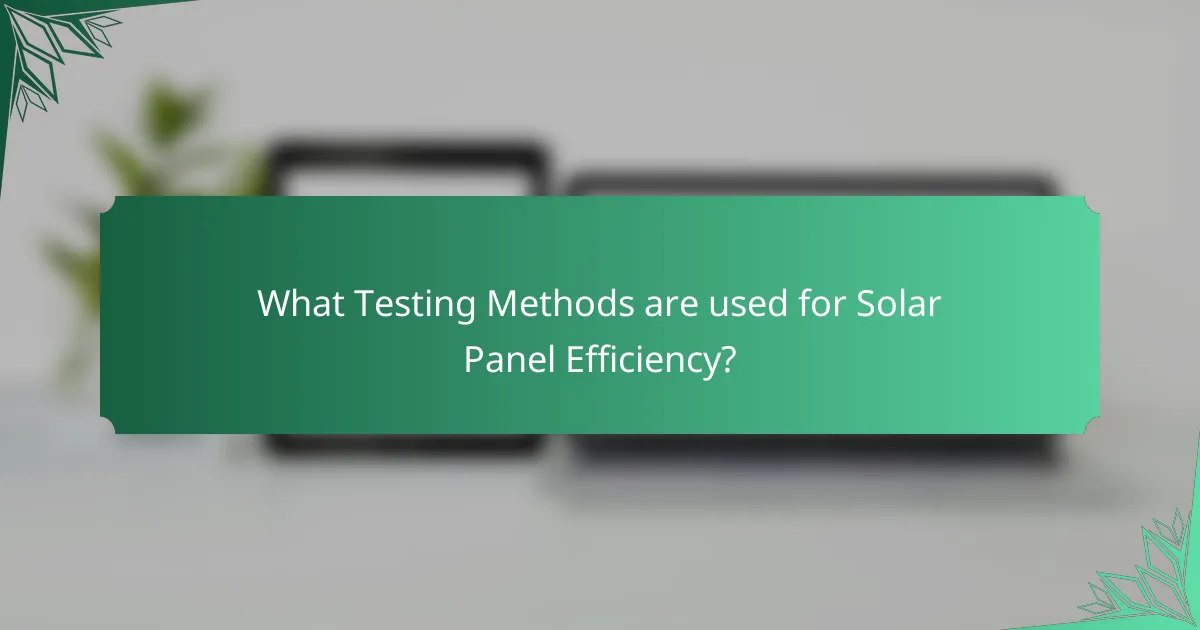
What are Solar Panel Efficiency Ratings?
Solar panel efficiency ratings measure how effectively a solar panel converts sunlight into usable electricity. These ratings are expressed as a percentage. Higher percentages indicate more efficient panels. For example, a panel with a 20% efficiency rating converts 20% of sunlight into electricity. Efficiency ratings are determined through standardized testing methods. The most recognized testing standard is IEC 61215. This standard evaluates performance under specific conditions. Efficiency impacts overall energy production and cost-effectiveness. Therefore, consumers should consider these ratings when selecting solar panels.
How are Solar Panel Efficiency Ratings determined?
Solar panel efficiency ratings are determined by measuring the amount of sunlight converted into usable electricity. This process involves standardized testing under controlled conditions. The most common standard for testing is the International Electrotechnical Commission (IEC) 61215.
During testing, panels are exposed to a specific light intensity, typically 1000 watts per square meter. The output power is measured and compared to the input power. The efficiency is then calculated using the formula: efficiency = (output power/input power) x 100%.
Typically, high-efficiency panels achieve ratings above 20%. Manufacturers may also provide information on temperature coefficients. This data shows how efficiency changes with temperature variations.
What factors influence the efficiency of solar panels?
The efficiency of solar panels is influenced by several key factors. These factors include the quality of materials used in the panels. Higher quality materials generally lead to better efficiency. Another factor is the angle of installation. The angle affects sunlight exposure, impacting energy conversion rates. Temperature also plays a significant role. Solar panels can lose efficiency at higher temperatures. Additionally, shading from trees or buildings reduces the amount of sunlight hitting the panels. Dust and dirt accumulation can also diminish performance. Finally, the technology used in the solar cells, such as monocrystalline or polycrystalline, affects overall efficiency. Each of these factors contributes to the overall performance and effectiveness of solar panels.
How do different types of solar panels compare in efficiency ratings?
Monocrystalline solar panels generally have the highest efficiency ratings, typically ranging from 15% to 22%. Polycrystalline panels follow, with efficiency ratings between 13% and 16%. Thin-film solar panels usually have lower efficiencies, ranging from 10% to 12%. The efficiency of monocrystalline panels is due to their high purity silicon, which allows for better electron movement. Polycrystalline panels, made from multiple silicon crystals, have slightly lower efficiency because of their manufacturing process. Thin-film panels are less efficient but offer advantages like flexibility and lightweight design. These efficiency ratings are critical for determining the overall energy output and suitability for specific installations.
Why are Solar Panel Efficiency Ratings important?
Solar panel efficiency ratings are important because they indicate how effectively a solar panel converts sunlight into electricity. Higher efficiency ratings mean more energy production from the same amount of sunlight. This directly impacts the overall performance of a solar energy system. For example, a panel with a 20% efficiency rating produces more energy than one with a 15% rating under identical conditions. Efficiency ratings also influence the space required for installation. More efficient panels require less space to generate the same amount of energy. Additionally, these ratings help consumers compare different solar products. They provide a standardized measure for evaluating performance. Understanding efficiency ratings can lead to better investment decisions in solar technology.
What impact do efficiency ratings have on energy production?
Efficiency ratings directly influence energy production by determining how effectively a solar panel converts sunlight into electricity. Higher efficiency ratings indicate that a greater percentage of sunlight is transformed into usable energy. For instance, a solar panel with a 20% efficiency rating converts 20% of the incoming solar energy into electricity, while a 15% rated panel converts only 15%.
This difference can significantly affect the overall energy output. Higher efficiency panels produce more electricity in the same amount of space compared to lower efficiency panels. As a result, installations using higher-rated panels can achieve better energy yields, leading to lower energy costs over time.
Furthermore, according to the National Renewable Energy Laboratory, every 1% increase in efficiency can lead to approximately 10% more energy production over the lifetime of the solar panel. Thus, efficiency ratings are critical in optimizing energy production and enhancing the economic viability of solar energy systems.
How do efficiency ratings affect consumer choices?
Efficiency ratings significantly influence consumer choices in solar panels. Higher efficiency ratings indicate better energy production from the same amount of sunlight. Consumers often prefer panels with higher ratings for their potential to lower electricity bills. For example, panels rated above 20% efficiency are typically seen as more desirable. This preference is driven by the perception of long-term savings and better performance. Additionally, consumers may associate higher efficiency with superior technology and reliability. Studies show that efficiency ratings can directly impact purchasing decisions, with many buyers willing to pay a premium for higher-rated products. Thus, efficiency ratings play a crucial role in shaping consumer preferences and market trends in solar panel selection.

What Testing Methods are used for Solar Panel Efficiency?
The testing methods used for solar panel efficiency include standard laboratory testing, field testing, and performance monitoring. Standard laboratory testing measures the efficiency under controlled conditions. This typically involves using a solar simulator to replicate sunlight. Field testing assesses performance in real-world conditions. It evaluates how environmental factors affect efficiency. Performance monitoring involves tracking energy output over time. This method provides data on long-term efficiency and degradation. Testing is often conducted according to standards set by organizations like IEC and UL. These standards ensure consistency and reliability in results.
How is the performance of solar panels tested?
The performance of solar panels is tested using standardized procedures. These tests measure efficiency, output, and durability. The most common testing standard is IEC 61215. This standard evaluates performance under various conditions. Tests include measuring maximum power output and temperature coefficients. Additionally, panels undergo stress tests for environmental factors like humidity and temperature. Certification bodies conduct these tests to ensure reliability. For example, the National Renewable Energy Laboratory (NREL) performs rigorous assessments. Their findings help consumers and manufacturers understand panel performance.
What are the common testing standards for solar panels?
Common testing standards for solar panels include IEC 61215 and IEC 61730. IEC 61215 evaluates the performance and durability of crystalline silicon solar panels. It includes tests for thermal cycling, humidity-freeze, and mechanical load. IEC 61730 focuses on the safety requirements for photovoltaic modules. This standard ensures protection against electric shock and fire hazards. Additionally, UL 1703 is a widely recognized standard in North America for safety and performance. These standards help ensure reliability and efficiency in solar panel systems.
How do lab tests differ from field tests in evaluating efficiency?
Lab tests and field tests differ significantly in evaluating efficiency. Lab tests are conducted in controlled environments. These tests isolate variables to measure performance under specific conditions. They provide consistent and repeatable results. For example, solar panel efficiency is often tested under standardized sunlight conditions.
In contrast, field tests occur in real-world settings. These tests account for varying environmental factors. Weather, shading, and temperature can all influence performance. Field tests offer insights into how solar panels perform in everyday conditions. They reflect actual energy output over time.
Lab tests typically report peak efficiency ratings. Field tests reveal average efficiency, which may be lower due to real-world variables. Both testing methods are essential for comprehensive evaluations. Together, they provide a complete picture of solar panel performance.
What are the limitations of current testing methods?
Current testing methods for solar panel efficiency have several limitations. They often rely on standardized conditions that do not reflect real-world performance. This can lead to discrepancies between lab results and actual energy output. Testing methods may also focus primarily on peak efficiency, neglecting performance degradation over time. Additionally, they might not account for variations in temperature and weather conditions. Some methods lack comprehensive metrics for evaluating long-term reliability. Furthermore, testing can be expensive and time-consuming, limiting accessibility for smaller manufacturers. These limitations can impact consumer trust and decision-making in solar panel purchases.
What factors can affect the accuracy of testing results?
Factors that can affect the accuracy of testing results include environmental conditions, equipment calibration, and sample integrity. Environmental conditions such as temperature and humidity can influence the performance of solar panels during testing. Equipment calibration ensures that the measuring instruments provide accurate readings. Improperly calibrated equipment can lead to significant discrepancies in results. Sample integrity refers to the condition of the solar panels being tested. Damage or degradation can skew the performance data. Additionally, testing methodology and procedures must be standardized to ensure consistency across tests. Variations in testing protocols can lead to different outcomes, affecting the reliability of results.
How can testing methods be improved for better accuracy?
Testing methods can be improved for better accuracy by implementing standardized protocols. Standardized protocols ensure consistency across different testing environments. Utilizing advanced measurement technologies enhances precision in data collection. Regular calibration of testing equipment minimizes errors caused by equipment drift. Incorporating multiple testing scenarios accounts for variations in environmental conditions. Training personnel in best practices reduces human error during the testing process. Peer reviews of testing results can identify discrepancies and improve reliability. Studies show that adhering to these practices significantly increases the accuracy of testing outcomes.

What Certification Standards exist for Solar Panels?
Certification standards for solar panels include IEC 61215, IEC 61730, and UL 1703. IEC 61215 assesses the performance and reliability of crystalline silicon solar modules. This standard ensures that panels can withstand environmental stresses like temperature changes and humidity. IEC 61730 focuses on the safety of solar modules. It evaluates electrical and mechanical safety aspects to prevent hazards. UL 1703 is a standard used primarily in North America. It certifies the safety and performance of solar panels in various conditions. These standards are essential for ensuring quality and safety in solar energy products.
What are the key certification standards for solar panels?
The key certification standards for solar panels include IEC 61215, IEC 61730, and UL 1703. IEC 61215 evaluates the performance and reliability of crystalline silicon solar panels. It ensures that panels can withstand environmental stresses like temperature fluctuations and humidity. IEC 61730 focuses on the safety of solar modules. It assesses electrical and mechanical safety to prevent hazards. UL 1703 is a safety standard recognized in North America. It certifies that solar panels meet safety requirements for installation and operation. These standards are crucial for ensuring quality and reliability in solar technology.
How do certification standards ensure quality and performance?
Certification standards ensure quality and performance by establishing specific criteria that products must meet. These standards are developed by recognized organizations, such as the International Electrotechnical Commission (IEC) and Underwriters Laboratories (UL). They encompass rigorous testing protocols that assess various attributes, including efficiency, durability, and safety. For solar panels, adherence to certification standards indicates that products have undergone extensive evaluation under controlled conditions. This evaluation includes performance tests that simulate real-world conditions, ensuring reliability and longevity. The certification process also involves periodic audits to maintain compliance over time. As a result, consumers can trust certified products to perform as advertised, reducing the risk of subpar performance and enhancing overall consumer confidence.
What organizations are responsible for certifying solar panels?
The organizations responsible for certifying solar panels include Underwriters Laboratories (UL), International Electrotechnical Commission (IEC), and the National Renewable Energy Laboratory (NREL). UL provides safety and performance certifications for solar products. IEC sets international standards for solar panel testing and performance. NREL conducts research and testing to ensure solar technologies meet efficiency and reliability standards. These organizations ensure that solar panels meet safety, performance, and quality benchmarks. Their certifications are crucial for consumer trust and industry credibility.
Why should consumers consider certification when purchasing solar panels?
Consumers should consider certification when purchasing solar panels to ensure quality and reliability. Certification verifies that solar panels meet specific performance and safety standards. For example, panels certified by the International Electrotechnical Commission (IEC) undergo rigorous testing for durability and efficiency. This testing includes exposure to extreme weather conditions and long-term performance evaluations. Certified panels often come with warranties that guarantee their performance over time. Additionally, certified products can be eligible for incentives and rebates from government programs. These factors contribute to a more informed purchasing decision, ultimately leading to better investment in solar technology.
What are the benefits of choosing certified solar products?
Certified solar products offer reliability and assurance of quality. They meet established safety and performance standards. This certification often indicates higher efficiency rates. Studies show that certified products tend to have longer warranties. For example, the International Electrotechnical Commission (IEC) sets rigorous testing protocols. Products that pass these tests are less likely to fail prematurely. Certified solar products also enhance property value. Homebuyers often prefer homes with certified systems due to trust in performance.
How can certification influence warranty and support?
Certification enhances warranty and support by ensuring compliance with established industry standards. Certified products typically come with more robust warranties, reflecting manufacturer confidence. This assurance often leads to better customer support options. For instance, certified solar panels are generally backed by longer warranty periods, often exceeding 25 years. This is due to rigorous testing and quality assurance processes that certified products undergo. Additionally, certification can facilitate easier claims processing in case of defects. Manufacturers are more likely to honor warranties on certified products, as they meet specific performance criteria. Overall, certification fosters trust between consumers and manufacturers, leading to improved warranty and support experiences.
What best practices should be followed when evaluating solar panel efficiency?
When evaluating solar panel efficiency, consider the following best practices. First, examine the panel’s rated efficiency percentage. This indicates how effectively it converts sunlight into electricity. Next, verify the performance under standard test conditions (STC). STC provides a consistent basis for comparison. Evaluate temperature coefficients to understand how efficiency changes with temperature. Lower coefficients indicate better performance in high temperatures. Check for certifications from recognized organizations, such as IEC or UL. These ensure the panel meets industry standards. Review real-world performance data from installations. This data can provide insights into actual efficiency versus rated efficiency. Lastly, consider the warranty and longevity of the panel. A longer warranty often indicates confidence in the product’s durability and performance.
The main entity of this article is solar panel efficiency ratings, which measure how effectively solar panels convert sunlight into electricity. The article provides a detailed overview of how these ratings are determined, the factors influencing efficiency, and the comparison of different types of solar panels. It also discusses the importance of efficiency ratings in energy production and consumer choices, along with the testing methods and certification standards that ensure quality and reliability in solar products. Key topics include testing protocols, the impact of environmental conditions on performance, and best practices for evaluating solar panel efficiency.